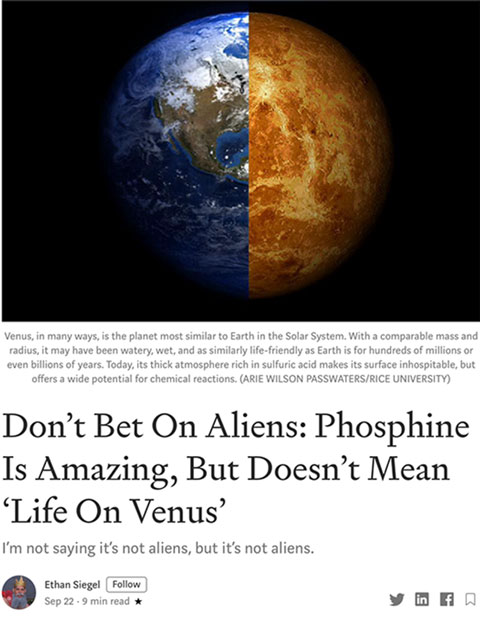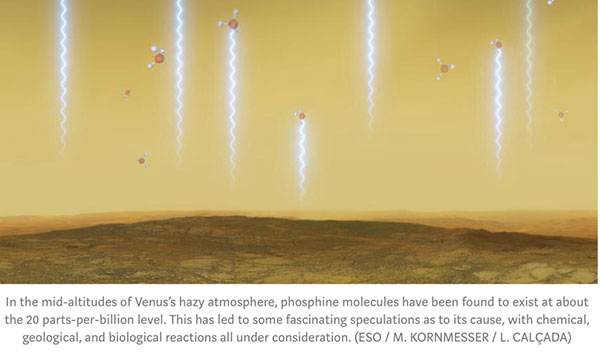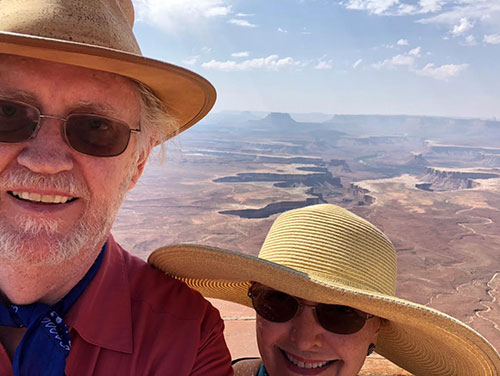Greetings from Palmia Observatory
Well we have been out of the observatory for a road trip through Nevada and southern Utah to visit the Canyonlands and Arches National Parks, but first let's mention the exciting news of discovery of phosphine and implications for possible life on Venus.
The radio observation of phosphine on Venus and its potential implications for life on our sister planet is in many news articles. Our summary here relies on the recent blog post, "It Starts with a Bang" by Ethan Siegel. He fills us in on some of the introductory details of the discovery and cautions us not to be very optimistic about the actual discovery of life.
 |
| Phosphine discovery on Venus (Source: Ethan Siegel, "It Starts with a Bang") |
The discovery of phosphine was made first by radio observatories, like the James Clerk Maxwell scope in Hawaii and then follow up observations with the ALMA observatory in Chile. By the looks of the received radio spectrum, the resonant dip due to phosphine is pretty noisy.
 |
| Radio Observatories discover Phosphine on Venus (Source: Ethan Siegel, "It Starts with a Bang") |
Now, if you are like me, I had forgotten or probably never really knew what the structure of phosphine was, so here you can see, thanks to Ethan Siegel's blog again, that the molecule is just on phosphorus atom with three hydrogen atoms. Sorry, I don't recall if the received spectroscopic radio signal corresponded to the vibratory or the rotary motions and resonances of the molecule.
 |
| Phosphine is a simple four atom molecule (Source: Ethan Siegel, "It Starts with a Bang") |
Previous lander missions to Venus have demonstrated the surface is very hostile and most probes do not last more than a few hours. The surface is very hot and the surface atmosphere is corrosive and life there is considered mostly impossible. But higher up in the Venusian atmosphere the conditions can be much more amenable for life.
 |
| Conditions to make phosphine in mid-altitudes on Venus (Source: Ethan Siegel, "It Starts with a Bang") |
On Earth, phosphine can be made in artificial chemical reactors, but is only made naturally by biological organisms. So, even though no natural means of making phosphine at those mid-altitude conditions is known, one still can't say that the phosphine is made biologically on Venus. Just consider all the work that went into possible sources of methane as seen on Mars. You have to look at all possible sources and sinks. So, the analysis for Venus is still ongoing. Keep in mind too that the detected levels of phosphine are only at the 20 parts per billion. We will have to wait and see!
 |
| But, just like for methane on Mars, you have to check all sources (Source: Ethan Siegel, "It Starts with a Bang") |
Ok, we need to wait for more analysis before we start to really imagine life existing on Venus, so in the meantime let's transition to our road trip through some pretty inhospitable regions in southern Utah, but through some very unusual and beautiful and stunning natural scenery. We were getting a little tired of being in this pandemic shutdown, but it seemed that a little road trip was probably safe enough and was just the thing we needed. Most of the places we stayed or stopped to eat had various levels of safety processes in place and we felt relatively safe in our adventure out on the road. In Canyonlands National Park you can see the natural wonder of eroded landscapes and everything is all outdoors.
 |
| First view of Canyonlands National Park (Source: Palmia Observatory) |
In Canyonlands, you find yourself mainly looking down on the valleys below. If you are truly adventurous there are other park entrances to get views from the valley floor too, but this was not for us, at least this time around. In the photo below you can see how the terrain has been carved out.
 |
| Resident Astronomers pose for selfie at Canyonlands National Park (Source: Palmia Observatory) |
Well as grand as Canyonlands was we were in for a much grander experience at Arches National Park. Again all of the natural landscapes carved out by erosion by wind and water created some really impressive rock structures.
 |
| Rugged structures and landscape at Arches National Park (Source: Palmia Observatory) |
There were locations where we had no cell phone coverage, so for safety reasons, we brought along our Garmin satellite phone. It has a built in compass function and GPS display and access to terrain maps as well. So as long as you have a clear line of sight to the sky, we had help if needed. The unit comes with a SOS button, so you can summon help in an emergency.
 |
| Cellphone coverage can be spotty, so bring your satellite GPS (Source: Palmia Observatory) |
Arches National Park is filled with hoodoos, which are erosion created rock structures, in addition to the abundant natural arches, all sculptured by wind and water. This balanced rock structure is one of many examples to be seen.
 |
| Wind eroded hoodoos are everywhere at Arches National Park (Source: Palmia Observatory) |
Another example of hoodoos in the Arches National Park. The incoming clouds kept the daytime temperature down, but would not have been too good for nighttime astronomical photography.
 |
| Hoodoos would make great astronomical backgrounds, but for the clouds (Source: Palmia Observatory) |
Of course, there are many arches to be seen everywhere in the park.
 |
| Resident Astronomer Peggy in front of a natural arch (Source: Palmia Observatory) |
The erosion that can make one arch can also generate multiple arches at the same location. Here is an example of three arches all together.
 |
| Arches can come in pairs and threesomes at Arches National Park (Source: Palmia Observatory) |
We also ran across this instructional panel that explained how arches are created and why they eventually fail and fall. Erosion first creates the arch, then erosion causes the arch to fail.
 |
| The rise and fall of an arch explained (Source: Palmia Observatory) |
There are many petroglyphs in the area and we found this set within just a short hike for the road.
 |
| Ancient petroglyphs in Arches National Park (Source: Palmia Observatory) |
We were also lucky enough to meetup with a deer on our brief hike up to one of the arches. She was just eating some lunch when I realized that I was the one that should change over to a different path. She did not seem to be disturbed much by my presence and she hung about quite a long time while we continued on our way.
 | |
|
After each day of hiking, we returned to Moab, UT and spent three nights there. Moab is well situated for visiting the national parks. Moab was also the site of one of the richest discoveries of uranium ore in the US back in 1952. That discovery was made by an oilfield geologist, who grew tired of writing reports for Standard Oil and eventually was fired and moved on to trying to find uranium in response to the newly formed Atomic Energy Commission (AEC) prize award for new discoveries. Anyway, Charlie knew the rocks and strata necessary for uranium ore and proved ultimately, even though it took his last dollar, that ground originally declared useless by the AEC, actually was a major ore discovery. When Charlie became a millionaire, he built a magnificent mansion high on the hillside, which now has been turned into a restaurant with a great view of the valley below.
 |
| Sunset in Moab at Charlie Steen's former residence, now Sunset Grill, in Moab (Source: Palmia Observatory) |
During our road trip we stopped at the Green River Museum for a bit of background and history of the Green and Colorado Rivers. By chance, I found this book on the museum shop shelves. I mentioned to Resident Astronomer Peggy that one of my ancestors had indeed been one of those brave souls that crossed the plains with a handcart. The story of over 2000 emigrants, who came from various parts of England and Europe, after becoming Mormons and hearing about living in the new Zion of Utah, elected to leave behind a life of poverty and make the journey over 1000's of miles to a new land of freedom and opportunity. This book describes all the hardships and heartbreaks of starvation, exhaustion and death of making the journey. Each of the companies of pioneers was made up of something like a 100 handcarts, a few oxen power wagons, and maybe 500 total pioneers. Check out the book for all of the details if you are interested.
 |
| Epic journey by handcarts to Utah (Source: L. Hafen and A. Hafen) |
It turns out that my sister, Ilene, who still lives nearby in southern Utah, knew the story of our ancestor and the handcart journey. My understanding is that one of our grandparent's great-grandmother, Hannah Baldwin, born in Warwickshire, England, in 1839, made one of the first companies of handcard migrations in 1856. She was just a single, unmarried woman, when she joined the other immigrants who made up this first company of handcarts to make the journey. Wow, just imagine a young woman, about 18 years old, striking out on her own to cross the ocean and then trek across the US with all her possessions, and mostly just provisions for the months (from June through September) long journey to Utah! Hannah was too poor to afford a covered wagon with oxen, but rich enough to afford a handcart and not too poor to have to become an indentured servant to pay for the journey. The handcart journey went through Illinois, Iowa, Nebraska, and Wyoming until finally reaching Utah.
Ilene, after researching Hannah's story, found an old photograph and made a colorized portrait. Wow, I hadn't spent much time wondering about our ancestral history before, but it is pretty amazing to recognize the pioneer spirit that these early settlers had to possess to put up with a long trek through the wilderness. Thanks for letting us in on the story, Ilene!
 |
| Colorized portrait of Hannah Baldwin (Source: Ilene Deamer) |
So, the rest of us now have to put up with a few minor inconveniences as we drive through the wilderness on our little road trip, all the while knowing that we will shortly be able to eat just about anything we want and to sleep in a soft cozy bed. For us, we were only about an hour drive to the next town with services, not a journey of over 70 days without much help from anyone along the way. Thank you, Hannah, for persevering and all the the rest!
Until next time, here from our burrow, stay safe, as we recover more of our freedom,

No comments:
Post a Comment